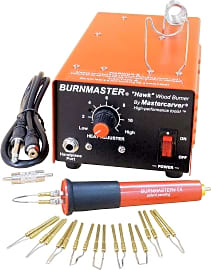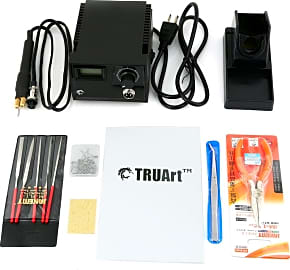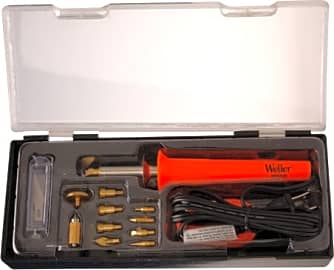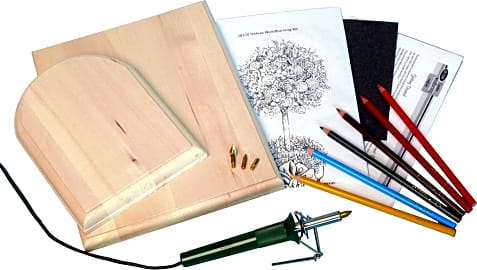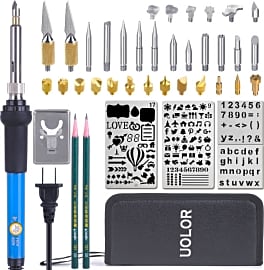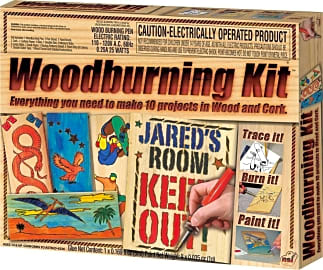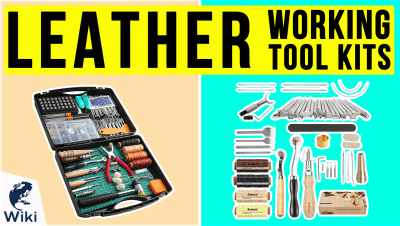The 10 Best Wood Burning Kits

This wiki has been updated 34 times since it was first published in March of 2017. The art of wood burning is popular for both crafting as well as DIY projects around the house, and the tool of choice is most often a pen-shaped device with a heated metal tip. Whether you are already an avid pyrographer who knows how to create intricate designs or are simply looking for a gift for a creative teen, we have included a variety of quality kits on this list to suit everyone's needs. When users buy our independently chosen editorial recommendations, we may earn commissions to help fund the Wiki.
Editor's Notes
July 16, 2020:
Added the Razertip SS-D10.
Although there are plenty of good solid-tipped woodburners, we tended to favor wire-tipped burners because of their heating and cooling times, and the ability they grant to produce great detail. Solid-tipped burners like the Truart B-1-34 use internal heating elements that then transfer the heat to the brass tips. This makes it so that it takes much longer to heat the tips - about 4-8 minutes - as opposed to wire-tipped pens, which normally take a few seconds. The other downside for brass burners is that most of them don't come with variable heat settings, so you can't vary the amps when you need less heat. Of course, you can buy a rheostat and install it somewhere on the power cord but that is beyond many consumers and can also be dangerous if done improperly.
The Razertip SS-D10 and the Burnmaster Hawk both have high outputs that can be controlled for shading or slow and fine work where you don't want the tip to dig into your workpiece. Since the power goes directly into the wire, they heat up a lot faster. Naturally, since the material is a lot thinner, they also cool a lot faster, allowing for quick tip changes, and a much lower likelihood that they'll start a fire if they accidentally fall. They offer plenty of power and versatility if you want to become a serious woodburner.
August 16, 2019:
We added the Burnmaster Hawk because it is a very high output burner (130 watt transformer) that will be the model of choice for many professionals. The size of the pen is ideal for detail work and it is also well-insulated. The tools is built to last with several fail-safes that protect the circuitry.
The Truart B-1-34 is at the top of the list because although it does not have a high-output burner (it just connects to the outlet), it is well-built and very affordable. The power can be adjusted and it doubles as a soldering iron.
Woodburning is very dangerous and safety measures should be taken to prevent personal injury.
The Tools In Wood Burning Kits
For those who are brand-new to wood burning, a kit makes a great choice because most contain nearly everything needed to get started.
For those who are brand-new to wood burning, a kit makes a great choice because most contain nearly everything needed to get started. But if you’ve never tried wood burning before, you may be wondering what, exactly, are all the items that come in a kit. So that you can get started designing and drawing sooner, we’ve outlined a few of the usual and important pieces included in wood burning kits.
First and foremost is the pyrography pen. These use electricity to heat up a tip that then burns into the wood. The better pens have a temperature control, as you won’t use the same temp when working with different woods. Hardwoods, for instance, require more heat. You should note that the tip of a wood burning pen becomes very hot, so you must exercise caution and always supervise children. Many kits include a pen stand, which will keep you from burning your table or hand as you work with the pen.
The tips of nearly all pyrography pens are removable, and the majority of kits come with a selection of tips with which you can work. These tips all have a slightly different shape and thickness for creating various lines and shading. At first, you might find this variety overwhelming, but as you practice with each one, you’ll get a better feel for what each can do.
Then, of course, there’s the wood. Not every kit includes wood, so if yours doesn’t, don’t worry. Any pieces of untreated scrap wood you have around the house will probably work just fine. For beginners, a soft wood without a strong grain is often the best choice; pine and spruce are popular. You’ll want a piece that’s whole and unvarnished, since stained wood or any pressed variety could release toxic substances as it burns.
You’ll also commonly find extra accessories in wood burning kits, such as stencils and colored pencils. These let you transform a project from just okay to wow. They can even make it easier for a beginner to achieve exciting results, as most don’t rely on artistic sketching or drawing ability. In other words, if you can follow directions and do some tracing, you’ll find yourself with an eye-catching finished object.
Ideas for Wood Burning Projects
Once you get the hang of holding the pen and start to feel a little more confident, you might be looking for new projects and design ideas. We can offer you a few to get you started. Just keep in mind that wood burning is a creative endeavor with no right or wrong answers, so don’t be afraid to experiment a little.
Once you get the hang of holding the pen and start to feel a little more confident, you might be looking for new projects and design ideas.
Many pyrography projects start with tracing. Stencils and freehand can be fun, but if you’d like to create a picture that is beyond your current skillset, then tracing is a great way to go. First, you select a picture and print it onto a sheet of white paper. Black and white images work best for this, especially for beginners. Place a sheet of carbon paper onto the wood, then place the printed paper on top. Secure the sheets with a few pieces of tape, then draw over the picture with an ink pen. When you remove the sheets, the design will have been transferred to the wood. For the best results, try to keep the longest lines in the design going with the grain, not against it.
You can use water-based wood stain to “color in” a design, much as you would do with colored pencils. Coloring in large areas is a great way for beginners to add more depth to a piece without having to use shading.
Then, you might try different objects. You’ll see many pyrography pictures on flat pieces of wood for hanging, but wood burning can be done on a range of items. One common choice is kitchen items, such as wooden spoons and spatulas or cutting boards. Hangers can be fun to jazz up, too, as are wooden boxes for trinkets. You could even use many small wooden discs to create a wreath. Just remember to start with untreated items to avoid toxic fumes.
Or, you could move away from wood altogether. Plenty of other surfaces hold up to this form of artistic burning, including leather, gourds, canvas, and cloth. The heat needed to create designs on these materials varies, as does the type of smell and/or fumes that they release. Also, items that are round, like gourds, will require a little more finesse, as it’s harder to draw on a curved object than a flat one.
A Brief History Of Pyrography
Wood burning is not a new art form, by any means. Although there isn’t hard evidence, some think it’s likely that ancient man used heated sticks to create designs on the walls of caves. The first true evidence of wood burning comes from China’s Han Dynasty, during which time practitioners referred to it as fire needle embroidery. There’s little, if anything, recorded about it between that time and the Victorian era, which is when it started to gain popularity. To the Victorians, it was known as pokerwork, later coming to be called pyrography, from the Greek for “writing with fire.”
Because the new device used a gaseous mixture to keep the tip hot, the process became much easier than the old method, which involved heating and reheating pokers in a fire.
Pyrography might not have caught on as well as it did if it weren’t for the invention of the cauterization machine in 1877 by Claude Paquelin. Although this device was intended for use by physicians, François Manuel-Perier, an artist, adapted it for pyrography. Because the new device used a gaseous mixture to keep the tip hot, the process became much easier than the old method, which involved heating and reheating pokers in a fire. Then, in the early 20th century, electric pyrography tools followed.
Today, pyrography is both fine art form and casual hobby. Artists such as David Kreider and Dino Muradian are able to create stunning pieces that range from realistic to abstract, rivaling the works other artists create in more common mediums, such as charcoals or paint. Many cultures indulge in wood burning, as well, with pyrography respected as a folk art across the globe, from South America to Eastern Europe


